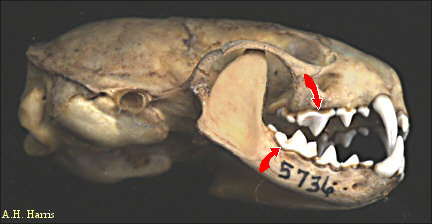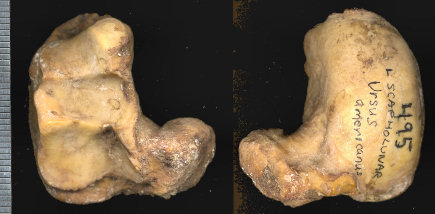Class Mammalia
Order Carnivora
Felidae—Cats // Hyaenidae—Hyaenas // Canidae—Wolves and Relatives // Felidae/Ursidae—Cats or Bears // Ursidae—Bears // Otariidae—Eared Seals // Mustelidae—Weasels and Relatives // Mephitidae—Skunks // Procyonidae—Raccoons and Relatives
The taxonomic order Carnivora consists of a clade of mammals that mostly partake of a considerable amount of flesh in their diets. However, the clade also includes taxa ranging from some that take almost no plant material to those that are herbivorous. The term differs from "carnivorous" and "carnivores" to the extent that many mammals include flesh in their diets but are not closely related to members of the order and thus belong to different taxonomic groups.
Fig. 1. Skull of Mustela frenata (Long-tailed Weasel). Arrows point to P4 and m1, the carnassial pair.
 One morphological characteristic of the order
is the presence of a carnassial pair of teeth consisting of P4 and m1, or of a pair of
teeth that evolved from such a carnassial pair. The carnassials are especially adapted
for slicing in most carnivores, though some members of the order have evolved crushing
teeth from such carnassials. Carnassial teeth are compressed to form blade-like cutting
edges, although many also have a posterior part that combines crushing and shearing.
All carnivores also have well developed canine teeth. Carnivores dependent on capture
of prey (rather than being omnivorous or herbivorous) have a glenoid fossa (the socket
of the jaw joint) that partially surrounds the condyloid process of the dentary,
providing support during powerful biting and pretty much limiting movement to the
vertical plane.
One morphological characteristic of the order
is the presence of a carnassial pair of teeth consisting of P4 and m1, or of a pair of
teeth that evolved from such a carnassial pair. The carnassials are especially adapted
for slicing in most carnivores, though some members of the order have evolved crushing
teeth from such carnassials. Carnassial teeth are compressed to form blade-like cutting
edges, although many also have a posterior part that combines crushing and shearing.
All carnivores also have well developed canine teeth. Carnivores dependent on capture
of prey (rather than being omnivorous or herbivorous) have a glenoid fossa (the socket
of the jaw joint) that partially surrounds the condyloid process of the dentary,
providing support during powerful biting and pretty much limiting movement to the
vertical plane.
Most carnivores have an os baculum (penis bone), an example of which can be seen for Ursus. One suggestion for its presence is that it allows prolonged copulation in forms that have induced ovulation (that is, forms that ovulate in response to copulation rather than having spontaneous ovulation). The os baculum (or just "baculum") occasionally shows up as a fossil and usually is identifiable to species or a small species group.
 The centrale, scaphoid, and lunar carpals of
the wrist are fused into a single element, the scapholunar. Generally, the clavicle is
reduced, allowing increased stride and, where contact is lost between shoulder girdle
and sternum, allowing the forelimb/girdle complex to act as a shock absorber (with no
contact between forelimb/girdle and the remainder of the skeleton, the forelimb shock
is taken up entirely by muscle tissue). Claws are characteristic of carnivores and, in
most felids, may be retractile; that is, the terminal phalanx is able to rotate to the
point that the claw doesn't meet the ground.
The centrale, scaphoid, and lunar carpals of
the wrist are fused into a single element, the scapholunar. Generally, the clavicle is
reduced, allowing increased stride and, where contact is lost between shoulder girdle
and sternum, allowing the forelimb/girdle complex to act as a shock absorber (with no
contact between forelimb/girdle and the remainder of the skeleton, the forelimb shock
is taken up entirely by muscle tissue). Claws are characteristic of carnivores and, in
most felids, may be retractile; that is, the terminal phalanx is able to rotate to the
point that the claw doesn't meet the ground.
Fig. 2. Two views of the left scapholunar of Ursus americanus. Modern specimen. Scale in mm.
In any one place and time, there usually are a variety of members of the Carnivora adapted for different types of prey, though the number of individuals tends to be low compared to the number of prey.
Last Update: 22 Nov 2013